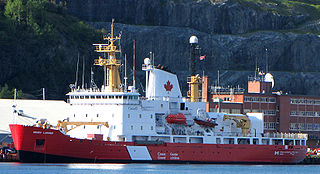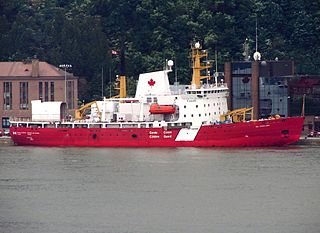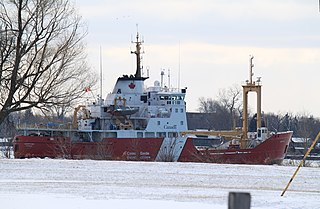
CCGS Henry Larsen is a Canadian Coast Guard Improved Pierre Radisson-class icebreaker serving in the Newfoundland and Labrador region and based in St John's, Newfoundland and Labrador. Entering service in 1988, Henry Larsen is the fourth ship and of an improved design over the rest of the ships in her class. The ship operates in the Arctic Ocean during summer months.

CCGS Samuel Risley is a Canadian Coast Guard icebreaker and buoy tender assigned to the Great Lakes area. Lead ship of her class, the vessel is named after Samuel Risley, the 19th century maritime inspector and first head of Board of Steamship Inspectors for Upper Canada and Ontario. Based in the Great Lakes, CCGS Samuel Risley is responsible for keeping an ice-free passage between Port Colborne, Ontario and Thunder Bay, Ontario.

CCGS Amundsen is a Pierre Radisson-class icebreaker and Arctic research vessel operated by the Canadian Coast Guard. The vessel entered service in 1979 as Franklin and was renamed Sir John Franklin in 1980 and served as such until 1996. Declared surplus, the vessel was used as an accommodation ship in Labrador in 1996 and placed in reserve in 2000. In 2003, the ship was reactivated and underwent conversion to an Arctic research vessel. The ship recommissioned as Amundsen.

CCGS Labrador was a Wind-class icebreaker. First commissioned on 8 July 1954 as Her Majesty's Canadian Ship (HMCS) Labrador in the Royal Canadian Navy (RCN), Captain O.C.S. "Long Robbie" Robertson, GM, RCN, in command. She was transferred to the Department of Transport (DOT) on 22 November 1957, and re-designated Canadian Government Ship (CGS) Labrador. She was among the DOT fleet assigned to the nascent Canadian Coast Guard (CCG) when that organization was formed in 1962, and further re-designated Canadian Coast Guard Ship (CCGS) Labrador. Her career marked the beginning of the CCG's icebreaker operations which continue to this day. She extensively charted and documented the then-poorly-known Canadian Arctic, and as HMCS Labrador was the first ship to circumnavigate North America in a single voyage. The ship was taken out of service in 1987 and broken up for scrap in 1989.

CCGS Des Groseilliers is a Pierre Radisson-class icebreaker in the Canadian Coast Guard. The vessel is named after Médard Chouart des Groseilliers (1618–1669) a close associate of Pierre-Esprit Radisson in explorations west of the Great Lakes and the founding of the British Hudson's Bay Company. The ship entered service in 1982. The vessel has participated in a number of research voyages, including Ice Station SHEBA. As part of the Surface Heat Budget of the Arctic Ocean experiment conducted in the Arctic Ocean from October 1997 to October 1998 to provide polar input to global climate models, Des Groseilliers was allowed to be frozen into the ice for the Arctic winter, to serve as a base for scientific researchers.

CCGS John A. Macdonald was a Canadian Coast Guard heavy icebreaker. She was named after The Right Honourable, Sir John Alexander Macdonald, the first Prime Minister of Canada. The ship was commissioned into the Canadian Department of Transport's Marine Service in 1960 using the prefix "Canadian Government Ship" (CGS). The vessel was transferred in 1962 into the newly created Canadian Coast Guard (CCG) and served with distinction until being decommissioned in 1991, and replaced by the then-chartered CCGS Terry Fox.

CCGS N.B. McLean was a Canadian Coast Guard icebreaker. Constructed in 1930 at Halifax Shipyards, she entered service as CGS N.B. MacLean and served in the Department of Transport's Marine Service, using the prefix "Canadian Government Ship". The ship was transferred into the newly created Canadian Coast Guard in 1962. She served in the St. Lawrence River and Gulf of St. Lawrence until she was decommissioned in 1979, and taken to Taiwan to be scrapped in 1989. She was replaced by CCGS Pierre Radisson.

CCGS Simcoe was a Canadian Coast Guard buoy tender and light icebreaker. The second vessel of the name in Canadian government service, Simcoe was in service from 1962 to 2007 based out of the Coast Guard base at Prescott, Ontario working the Great Lakes and Saint Lawrence Seaway. In 2008 the ship was sold to commercial interests.

CCGS D'Iberville was a Canadian Coast Guard icebreaker that was in service from 1952 to 1983 and was Canada's first modern icebreaker. The ship commissioned as CGS D'Iberville for the Department of Transport's Marine Service, using the prefix "Canadian Government Ship", D'Iberville was transferred into the newly-created Canadian Coast Guard in 1962. When launched, she was the largest icebreaker in use by Canada post-World War II until CCGS John A. Macdonald was put in service. In 1984, the icebreaker was renamed Phillip O'Hara before returning to her old name in 1988. In 1989 the vessel was sold for scrap and broken up at Kaohsiung, Taiwan.

CCGS Pierre Radisson is the lead ship of her class of icebreakers. Constructed and operated by the Canadian Coast Guard, the vessel is based at Quebec City on the Saint Lawrence River. The ship was constructed in British Columbia in the 1970s and has been in service ever since. The vessel is named for Pierre-Esprit Radisson, a 17th-century French fur trader and explorer.
CCGS Earl Grey is a Samuel Risley-class light icebreaker and buoy tender in the Canadian Coast Guard. Constructed in 1986, the vessel serves a variety of roles, including light ice-breaking and buoy tending, as well as being strengthened for navigation in ice to perform tasking along the shores off the Atlantic coast of Canada. Like her sister ship, CCGS Samuel Risley, she carries a large and powerful crane on her long low afterdeck for manipulating buoys. Earl Grey is the second icebreaker in Canadian service to carry the name.

CCGS George R. Pearkes is a Martha L. Black-class light icebreaker and buoy support vessel in the Canadian Coast Guard. Named for Victoria Cross-winner George Pearkes, the ship entered service in 1986. Initially assigned to Pacific region, the vessel transferred to the Quebec region. George R. Pearkes was assigned to her current deployment, the Newfoundland and Labrador region in 2004.

Canadian Coast Guard Ship Griffon is a Canadian Coast Guard (CCG) high endurance multi-tasked vessel and light icebreaker stationed in Prescott, Ontario, Canada. Completed in 1970, Griffon provides icebreaking services along eastern Lake Ontario and upriver along the Saint Lawrence River to Montreal.

CCGS Sir Humphrey Gilbert is a former Canadian Coast Guard light icebreaker and buoy tender that was later sold to a private owner and renamed Polar Prince. The ship entered service with the Department of Transport Marine Service in 1959 and transferred to the newly created Canadian Coast Guard in 1962, active until 2001. The icebreaker was sold to private interests in Newfoundland and renamed Polar Prince, sitting mostly idle until resold in 2009 to GTX Technology Canada Limited for service in the Arctic Ocean as a commercial icebreaker. In 2017, the vessel was temporarily rechristened Canada C3 and used for a high-profile voyage around Canada's three maritime coasts as part of the nation's 150th anniversary. In November 2021, the ship was purchased by Miawpukek Horizon Maritime Service Ltd, a joint venture between Horizon Maritime and the Miawpukek First Nation and chartered for educational and research expedition use.
CCGS J.E. Bernier was a Canadian Coast Guard medium Arctic icebreaker with a steel hull. The vessel was in service from 1967 to 2006. The ship was initially based at Quebec City but finished her career at St. John's. The ship was named for Joseph-Elzéar Bernier, captain of CGS Arctic which explored and monitored the eastern Arctic for the Government of Canada in the early 20th century. The vessel was sold in 2006 to private interests.

CCGS Ernest Lapointe was a Canadian Coast Guard light icebreaker that served for 37 years. Completed in 1941, Ernest Lapointe was taken out of service in 1978. The ship was active along the East Coast of Canada and in the Saint Lawrence River. In 1980, the vessel was turned into a museum ship in Quebec.

The Martha L. Black-class icebreakers are a class of six light icebreaker and buoy tenders constructed for and operated by the Canadian Coast Guard. Built in the 1980s, the class operates on both coasts of Canada and have been used for operations in the Arctic region, including the search for the ships of Franklin's lost expedition. They are rated as "high endurance multi-tasked vessels" under Canadian Coast Guard naming rules.

The Samuel Risley-class icebreakers are a class of two icebreakers and buoy tenders constructed for and operated by the Canadian Coast Guard. The two ships are based on offshore supply tugboat design and entered service in the 1980s. Samuel Risley is deployed to the Central Region, operating mainly on the Great Lakes of North America, while Earl Grey is posted to Atlantic Canada, working off the east coast of Canada.

CGS C.D. Howe was a Canadian Arctic patrol vessel tasked with controversial missions that served first with the Department of Transport, then the Canadian Coast Guard. Conceived as a way to make Canada's presence in the Arctic more visible, C.D. Howe entered service in 1950. The ship would make an annual voyage to Canada's north in the summer months, visiting remote communities to resupply them and to provide medical and dental services. The patrol vessel would sometimes remove members of Aboriginal communities to the south for further treatment. The ship was also involved in a forced resettlement of Inuit families in the High Arctic. During winter months, C.D. Howe provided services in the Gulf of St. Lawrence. In 1962, the ship joined the Canadian Coast Guard and was given the new prefix CCGS. C.D. Howe was deemed obsolete in 1969 and taken out of service. In 1970 the vessel was sold, becoming an accommodation vessel in Greenland before being broken up for scrap in 1975.

The Pierre Radisson-class icebreakers, also known as R-class icebreakers, are a class of four icebreakers constructed for and operated by the Canadian Coast Guard. The Canadian Coast Guard designates the four ships in the class as medium icebreakers. Built in two phases, the first three ships, Pierre Radisson, Franklin and Des Groseilliers, were built to a common design. The fourth, Henry Larsen was built to a modified design and is considered a subclass, the Improved R-class icebreaker. Franklin was later renamed Sir John Franklin before undergoing a re-design for use primarily as an Arctic research vessel. Upon the vessel's return to service, the ship was once again renamed Amundsen. All the vessels are named for people who sailed through Canada's northern waters. The class operates in the Arctic Ocean in the summer, patrolling, icebreaking and research missions.
















